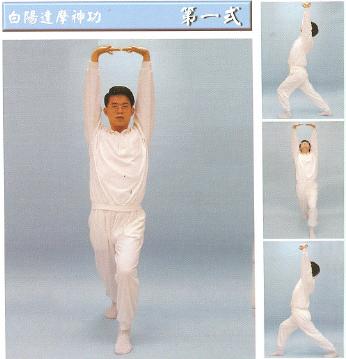En:達摩神功-1白陽開泰
出自白陽先天大道
(修訂版本間差異)
(创建新页面为 '<div id="大明山維基站"></div> <!-- Beginning of header section -->{|style="width:100%;margin-top:+.7em;background-color:#fcfcfc;border:1px solid #ccc" |style="width:56%;co…') |
|||
| 第10行: | 第10行: | ||
|}<!-- Portals Follow --> | |}<!-- Portals Follow --> | ||
|style="width:14%;font-size:95%;color:#000"| | |style="width:14%;font-size:95%;color:#000"| | ||
| - | [[ | + | [[達摩神功-1白陽開泰| 中文]] |
|}<!-- End Portals --> | |}<!-- End Portals --> | ||
[[Image:Damoa1-1.jpg]] | [[Image:Damoa1-1.jpg]] | ||
| - | + | ||
| + | |||
| + | == Damoa Gong #1 Baiyang Opening == | ||
| + | |||
| + | #Bring your feet together facing the front. Hands hang down naturally to your sides. Stand straight. | ||
| + | #Take one big step forward with your left foot. Bend your left knee as shown in the picture above. Your right leg should be straight. Keep your head and waist straight. | ||
| + | #The inside of your left foot should lie in a straight line with the inside of your right foot. Your right heel should not lift up from the ground. | ||
| + | #Press your body down as low as possible. Close your mouth and bite down with your teeth. With the tip of your tongue, touch the roof of your mouth. Your toes should grab the floor firmly. | ||
| + | #Using the thoracic diaphragm, inhale slowly through your nose. At the same time, raise your arms and extend the palms upward facing the sky. Your hand/waist/arm should be at 90 degrees angle. | ||
| + | #Fully extend your fingers. Keep your arms straight up. Your middle fingers from both hands should be touching. | ||
| + | #Contract the rectum upward and keep your back straight. Hold your breath for 5 seconds. It should feel like you are pushing up with the top part of your body from the waist up. Your lower body should indepently maintain the original stance (press downward as described in step 4). | ||
| + | #Exhale slowly through your nose, at the same time lower your tongue, relax your body while bringing your arms down and retract the bent leg toward the body. | ||
| + | #An in and out breath counts as one cycle. Alternate your legs 6 cycles each to the right and left side for a total of 12 cycles. | ||
| + | |||
| + | ==Benefits== | ||
| + | This form, the most fumdamental of the 18, benefits your lungs and helps blood circulation while exercising your immune, lung, lymphatic, respiratory, and digestive systems. | ||
在2021年1月18日 (一) 15:51所做的修訂版本
|
Damoa Gong #1 Baiyang Opening
- Bring your feet together facing the front. Hands hang down naturally to your sides. Stand straight.
- Take one big step forward with your left foot. Bend your left knee as shown in the picture above. Your right leg should be straight. Keep your head and waist straight.
- The inside of your left foot should lie in a straight line with the inside of your right foot. Your right heel should not lift up from the ground.
- Press your body down as low as possible. Close your mouth and bite down with your teeth. With the tip of your tongue, touch the roof of your mouth. Your toes should grab the floor firmly.
- Using the thoracic diaphragm, inhale slowly through your nose. At the same time, raise your arms and extend the palms upward facing the sky. Your hand/waist/arm should be at 90 degrees angle.
- Fully extend your fingers. Keep your arms straight up. Your middle fingers from both hands should be touching.
- Contract the rectum upward and keep your back straight. Hold your breath for 5 seconds. It should feel like you are pushing up with the top part of your body from the waist up. Your lower body should indepently maintain the original stance (press downward as described in step 4).
- Exhale slowly through your nose, at the same time lower your tongue, relax your body while bringing your arms down and retract the bent leg toward the body.
- An in and out breath counts as one cycle. Alternate your legs 6 cycles each to the right and left side for a total of 12 cycles.
Benefits
This form, the most fumdamental of the 18, benefits your lungs and helps blood circulation while exercising your immune, lung, lymphatic, respiratory, and digestive systems.
